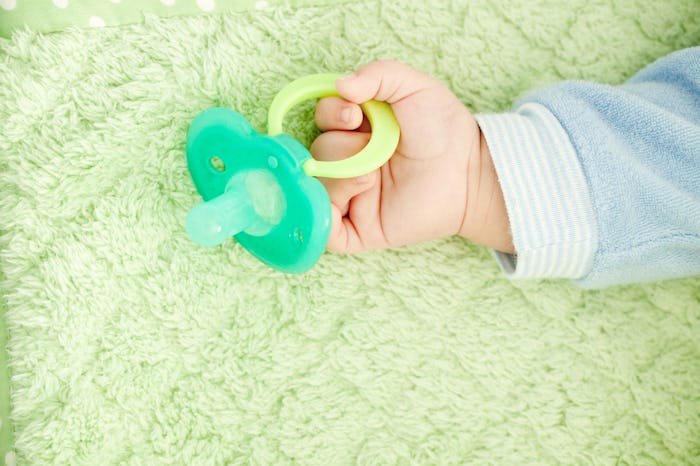Life

What Experts Want You To Know About Using A Pacifier After 6 Months
Ah, the pacifier. Is there a baby accessory more cherished by parents and yet still controversial? Some parents never introduce them because, "I don't want to start a habit I have to break." Other parents love the paci for the peace and quiet it provides. But before you know it, everyone is asking when you plan to take your child's beloved soothing object away. It no longer seems harmless now that your baby isn't a newborn, and you wonder, "Is it OK that my baby is 6 months and still taking a pacifier?"
Parents who feel ambivalent about giving their baby a pacifier will be comforted by Dr. Dave Tesini, DMD, MS, an expert in pediatric dentistry and orthodontics, and his answer to the question of whether or not it's OK for a 6-month-old baby to use one. Over email, Tesini says:
"The American Academy of Pediatrics, in fact, has recommended that all babies be offered a pacifier for sleeping and at nap time because it has been shown to help prevent SIDS. Up until the age of 1 year, these babies often still love their binkies because they are calming and soothing helpers at times of illness, overtiredness, or even during the teething process."
The red line, according to Tesini, is a child's first birthday. This is when "parents should start thinking that the time is coming close to wean their baby off of the pacifier before it develops into a persistent habit." Coincidentally, "age 1 is actually also the recommended time to schedule your baby’s first dental appointment and a perfect time to ask your pediatric dentists for hints at how to wean baby away from the pacifier."
Speaking of that first dental appointment, many parents who are eager to ditch the pacifier worry about long-term damage to their child's oral development. While early use may be harmless, Tesini explains that "as the baby gets older, the palate is also growing larger and the sucking pressure is becoming stronger; at this time, the design and size of the pacifier becomes very important. Without a proper size and design, the teeth and jaws will be affected. Parents will notice that the teeth may start to separate in the front and the upper jaw (palate) will become narrow."
While Tesini recommends pacifier weaning around one year of age, it is not uncommon to see toddlers, like David Beckham's 4-year-old daughter Harper, still using a paci for sleep and soothing. Romper asks Tesini why experts would prefer you not delay weaning until ages 3 to 4, despite your baby's resistance to give up the pacifier. Tesini explains:
"Dental research has found that changes to the mouth, teeth, and tongue function occur much earlier than that [age 3]. In fact, studies show that harmful effects from prolonged pacifier use generally start around 18 months of age. Genetics does play a role, as well as the number of hours a pacifier is used in a given day, but as a pediatric dentist, I routinely see 18 to 24 month toddlers with palatal collapse and anterior open bite that must now be treated with orthodontics."
Those conditions sound scary, so Tesini elaborates on the types of orthodontic work commonly associated with extended pacifier use. "Some infants and toddlers are more prone to developing orthodontic problems from a pacifier habit than others. This becomes even more apparent if mom or dad had orthodontic problems as a child. Prolonged pacifier use can cause the palate (upper jaw) to become narrow and constricted, and this results in the upper and lower teeth not being able to bite together correctly; pediatric dentists referred to this as a 'posterior crossbite.' Once a posterior crossbite develops, it is not self-correcting and the children do not 'outgrow' it; they must be treated with 'palatal expansion' and other costly orthodontic procedures by the pediatric dentist or orthodontist."
Finally, Romper asks Tesini if all pacifiers are created equal. He says no and recommends that parents choose pacifiers that are scientifically designed to prevent or minimize oral damage. For example, Tesini has been involved in the design of a new pacifier from Smilo that "supports a baby's palate, and expands slightly in a baby’s mouth to help prevent crossbite and collapsed palates, which can cause dental problems down the road."
In addition to design, Tesini stresses the importance of proper sizing. Pay attention to designations like "newborn," "3-6 months," and so on. Age-specific sizing will help to "encourage proper oral development," he says.
So is it OK for your baby to use a pacifier at 6 months? Sure. In fact, it can be beneficial. But it wouldn't hurt to start planning the weaning process so you can be prepared in an additional six months.